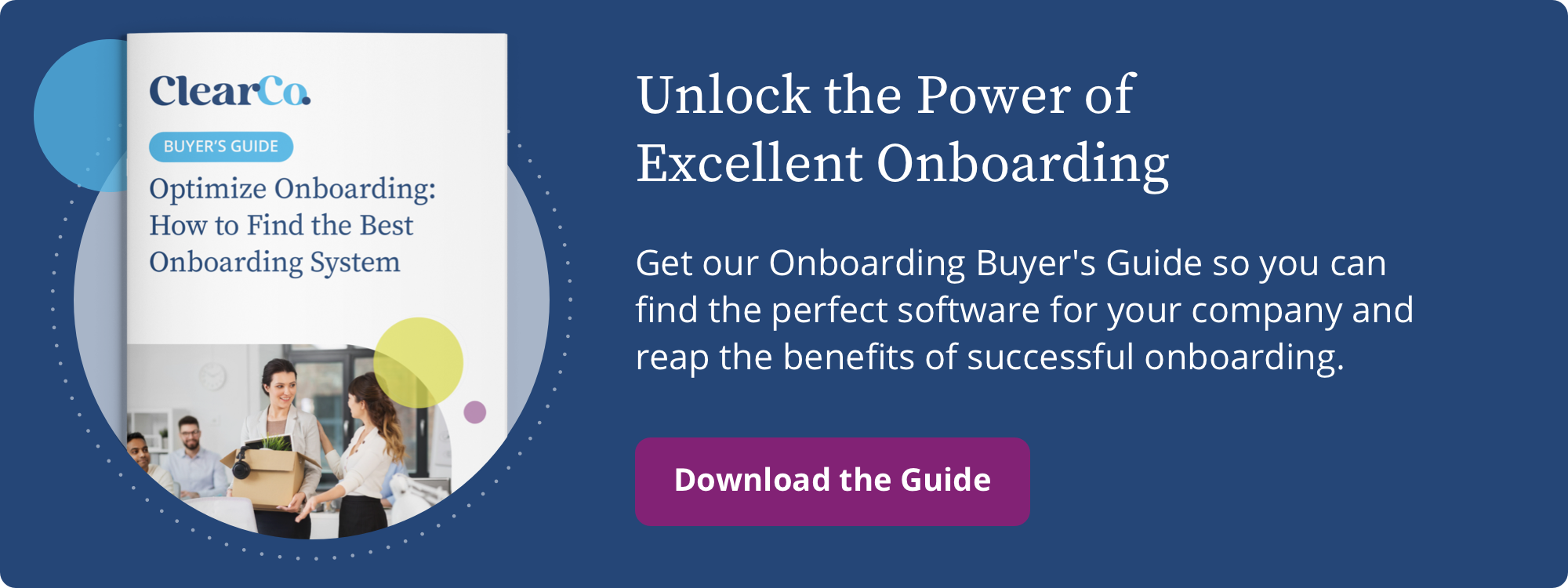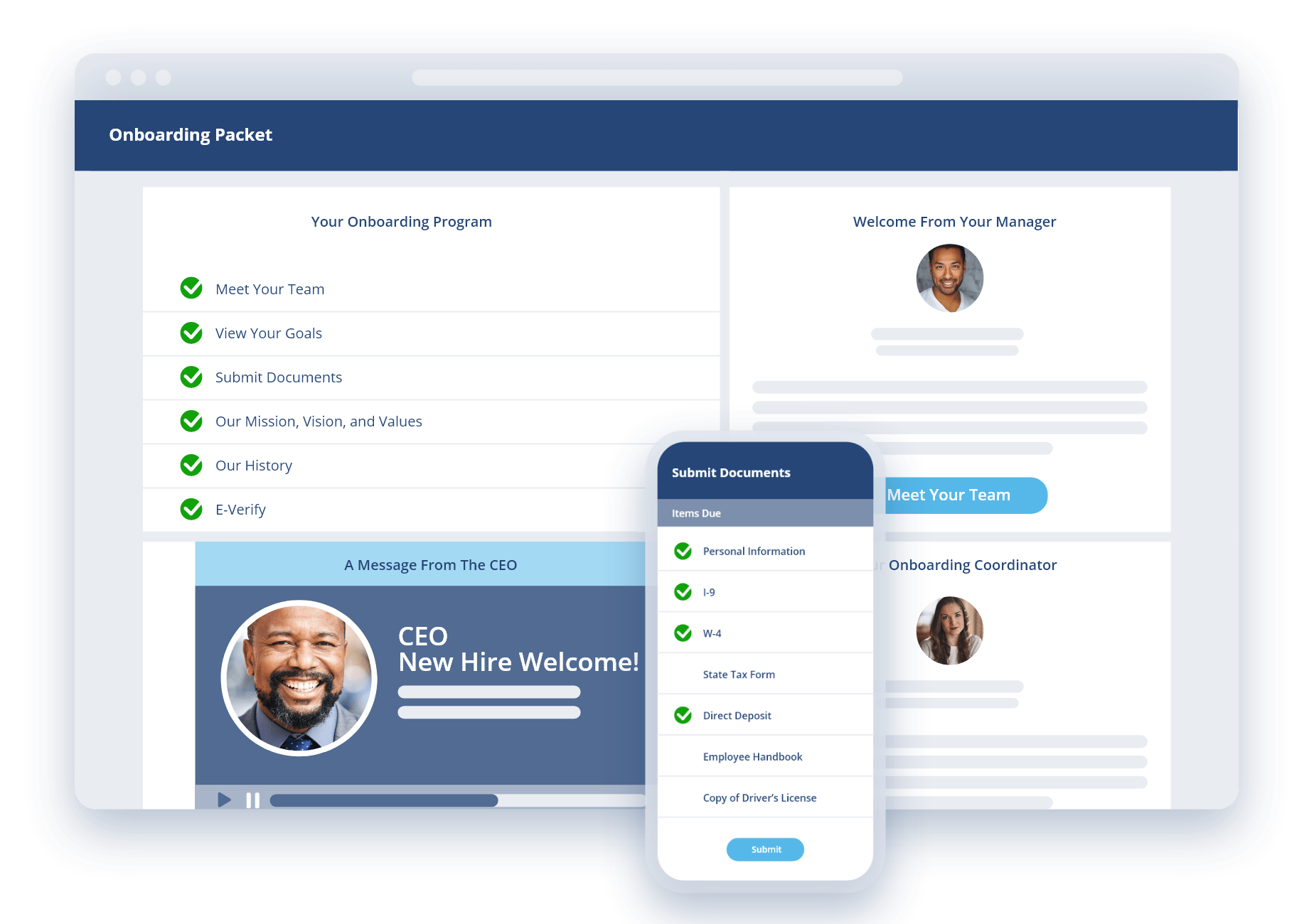This article was originally published in April 2019 and was updated in March 2024 with new information.
It’s finally here: your new hire’s first day. You’ve set up their desk space or shipped their equipment, compiled the paperwork they need to complete, and created an onboarding schedule. The onboarding process is in full swing, and it’s time to extend a warm welcome to your new employees. At the same time, you need to ensure onboarding compliance at every stage.
There’s a lot of emphasis, especially today, on the candidate and new hire experiences. While that’s for good reason, your HR team also has rules and regulations to follow when it comes to onboarding new employees. Compliance, one of the Four Cs of Onboarding, sets the tone for integrity and ethical conduct at your company. It also protects your organization from legal repercussions, damage to its reputation, and loss of trust that can occur from a lack of compliance.
Complying with laws regarding wages, employment verification, sick time off, maternity leave, equal opportunity, mandatory training, and more is of the utmost importance. But as an HR professional, onboarding isn’t just about helping new hires understand their roles and your company culture. You also have to balance new hire compliance tasks with creating an awesome onboarding experience.
We’ve compiled a list of best practices for integrating compliance tasks into your process for successful onboarding every time.
1. Establish a Compliance-Oriented Onboarding Program
Onboarding new employees can be fun —but first, you need to get the more serious steps out of the way. Ground your onboarding program in compliance-oriented tasks to mitigate risks and uphold legal standards. You can take a few key steps to ensure both new hires and HR team members complete these important tasks.
Prepare New Hire Welcome Packets
Put together new hire welcome packets (digitally if you use onboarding software) so there’s no confusion about which forms they need to fill out. Then, be sure to keep this paperwork on file and accessible. Required documents vary by employee and might include:
- Employment contracts or offer letters
- Tax forms, like W-4s
- Non-disclosure agreements (NDAs)
- Privacy policies and other work policies
Conduct Background Checks
Background checks help you verify the information your new employee has given and often need to be completed before their start date. Information you can confirm with a background check includes:
- Criminal background check: Screen for past convictions that could pose a risk to your company.
- Employment verification: Confirm past employment history.
- Education verification: Validate educational credentials.
If you’re using onboarding software, you can complete your background checks within the system, just like welcome packets.
Provide Compliance Training
Every workplace has a few standard federal or state-required training courses employees must complete. These training courses help employees understand both their own and their employer’s legal and ethical responsibilities. New hires also need to understand your company’s particular policies.
The Four Cs of Onboarding
- Compliance
- Clarification
- Culture
- Connection
Training and policies include:
- Anti-discrimination policies: Educate employees on your company’s policies against discrimination based on race, gender, age, or other protected traits. This could include harassment training
- Safety training: Many workplaces, especially in industries like construction or manufacturing, need to train employees on safety standards and first aid to ensure secure job sites.
- Code of conduct: Your code of conduct could be your company values or employee handbook. It outlines behavioral standards and expectations for ethical conduct within the workplace.
- Data protection policies: Train employees on how to handle sensitive data and stau compliant with data protection laws and regulations.
Keep Comprehensive Records
Maintaining organized employee records is extremely important when onboarding new hires and throughout their tenure. With onboarding software, these documents —and everything else you want to keep on file —are easily accessible by HR, hiring managers, and employees:
- Completed forms and training programs
- Securely stored background checks
- Signed agreements and acknowledgments
2. Review Existing Legislation
It’s essential to understand major employment laws that impact your organization to ensure onboarding compliance. Partner with your legal team to thoroughly review state-level legislation wherever your business operates.
While reviewing these laws, you may also want to consider looking into states in which your company plans to expand in the future. Your legal representatives should help to identify legislation that will have a direct impact on the compliance items on your onboarding checklist.
3. Subscribe to Compliance Updates
Employment laws are not static, so it’s important to pay attention to legislation that may impact your onboarding process. Subscribe to compliance updates from a trusted source to keep an eye on changing rules and regulations. You can get legal updates from sources like the U.S. Department of Labor, HR.BLR, or the Society for Human Resource Management (SHRM).
Many state governments and local law firms also provide notifications on new rules and their potential impact on different organizations. Reading through these updates and chatting with the legal team each time a law may potentially influence your processes helps you stay ahead of the game and avoid surprises.
4. Complete Internal Audits
One of the best ways to ensure compliance is to complete regular audits of your processes. At least once or twice per year, have an HR employee walk a legal employee through the onboarding process. This ensures your new hire process remains compliant and can prepare ahead of time for any changing laws or regulations. Completing these audits also helps protect your company and your employees from any potential legal repercussions.
5. Use Onboarding Software
We’ve mentioned a few ways that software helps facilitate a smooth, compliant onboarding process. Look for these compliance tools to find a top-notch onboarding system:
- Digital new hire welcome packets ensure every employee completes the correct forms for their roles and reduces the burden on HR.
- E-Verify and I-9 processing, powered by simplifi-9, streamline employment verification and help you keep excellent records.
- Intelligent forms enable quick digital signature capture and document storage.
- Task tracking and automatic notifications help HR and new hires complete every compliance-related task.
Companies must follow legislation set by each state in which they operate regarding wages, equal employment, pregnancy, and more. By following the above-mentioned steps, your organization can stay in compliance and reduce risk.
ClearCompany’s award-winning Onboarding System enables easy compliance for our clients. Our software will help streamline your new-hire processes with built-in Background Checks, digital new-hire welcome packets, onboarding checklists, and more.
Get in touch with a ClearCompany expert to see how you can simplify compliance tasks with our Onboarding System.
*ClearCompany recommendations are not legal advice. Research your state and federal laws and consult with an employment law professional to ensure onboarding compliance at your organization.



